Diagnostic Test - AP English Language and Composition Premium 2024
Section I
TIME: 1 HOUR
DIRECTIONS: Questions 1–12. Carefully read the following passage and answer the accompanying questions.
The passage below is an excerpt from an essay on violence in America, written by a contemporary historian.
Passage 1
On September 26, 1872, three mounted men rode up to the gate of the Kansas City Fair, which was enjoying a huge crowd of perhaps 10,000 people. The bandits shot at the ticket seller, hit a small girl in the leg, and made off for the woods with something less than a thousand dollars. It was highhanded, and it endangered the lives of a whole host of holiday-minded (5)people for comparatively little reward.
What makes the robbery and the violence notable is not the crime itself but the way it was reported in the Kansas City Times by one John N. Edwards. In his front-page story he branded the robbery “so diabolically daring and so utterly in contempt of fear that we are bound to admire it and revere its perpetrators.”
(10)Two days later the outlaws were being compared by the Times with knights of King Arthur’s Round Table:
“It was as though three bandits had come to us from storied Odenwald, with the halo of medieval chivalry upon their garments and shown us how the things were done that poets sing of. Nowhere else in the United States or in the civilized world, probably, could this (15)thing have been done.”
Quite likely this deed was perpetrated by the James brothers: Jesse and Frank, and a confederate. The details really do not matter. What pertains is the attitude of the innocent toward the uncertainly identified guilty. The act had been perpetrated by violent, lawless men. If the Times is any indication, a respectable section of people approved of their action. (20)No one, of course, thought to ask the little girl with the shattered leg how she felt about such courage. Nearly 17 months later, Edwards was quoted in the St. Louis Dispatch as preferring the Western highwayman to the Eastern, for “he has more qualities that attract admiration and win respect . . . . This comes from locality . . . which breeds strong, hardy men—men who risk much, who have friends in high places, and who go riding over the land, (25)taking all chances that come in the way.” The purpose here is not to belabor one reasonably anonymous newspaperman of nearly a century ago, but merely to point up a fact—and a problem—of the American frontier.
The frontier placed a premium on independent action and individual reliance. The whole history of the American frontier is a narrative of taking what was there to be taken. (30)The timid never gathered riches, the polite nearly never. The men who first carved the wilderness into land claims and town lots were the men who moved in the face of dangers, gathering as they progressed. The emphasis naturally came to be placed on gathering and not on procedures. Great tales of gigantic attainments abound in this frontier story; equally adventurous tales of creative plundering mark the march from Jamestown to the Pacific. It (35)was a period peopled by giants, towers of audacity with insatiable appetites. The heroes are not the men of moderate attitudes, not the town planners and commercial builders, not the farmers nor the ministers nor the teachers. The heroes of the period, handed along to us with all the luster of a golden baton, are the mighty runners from Mt. Olympus who ran without looking back, without concern about social values or anywhere they might be going (40)except onward.
We revere these heroes because they were men of vast imagination and daring. We have also inherited their blindness and their excesses.
1. In the opening paragraph of the passage (lines 1–5), the author tells the story of robbery primarily to
(A) portray the character of life in Kansas City.
(B) suggest that lawlessness was common back in the 1870s.
(C) juxtapose the action against the response to it.
(D) create suspense as to the identity of the outlaws.
(E) contrast the crowd’s enjoyment with the violence taking place in their midst.
2. In lines 6–15, which of the following best describes the writer’s main purpose?
(A) To condemn the opinions and writing style of a particular journalist
(B) To convey disapproval over the newspaper coverage of the incident at the fair
(C) To express shock about the public’s reaction to the crime
(D) To stress the uniqueness of America’s social and cultural history
(E) To imply that values and customs from the medieval world are still alive and well
3.The rhetorical effect of the sentence in lines 6–7 (“What makes . . . Edwards.”) is heightened by the strategy of
(A) using “What” as the first word, suggesting that a question will follow.
(B) emphasizing harsh words such as “crime” and “violence.”
(C) placing it immediately after the story of the robbery.
(D) asserting why the event was not noteworthy before saying why it was.
(E) following it up with a vividly written description of the robbery.
4. In context, the statement that “a respectable section of people approved of their action” (line 19) could be used to support which of these descriptions of the writer’s opinions about the events in Kansas City?
(A) He excuses the outlaws’ behavior because as Midwesterners they suffered hardships.
(B) He is more sympathetic toward Westerners than toward Easterners.
(C) He adopts a semi-admiring tone of the outlaws.
(D) He is outraged by the outlaws’ insensitivity.
(E) He is troubled by the public’s response to the episode.
5. The phrase “such courage” (lines 20–21) can best be interpreted as an example of
(A) a subtle use of irony.
(B) a metaphorical allusion.
(C) a witty aphorism.
(D) a paradox.
(E) an oxymoron.
6. The quotation from the St. Louis newspaper (lines 22–25) serves the author’s purpose in which of the following ways?
(A) It makes a pitch for more accuracy in news reporting.
(B) It makes clear the author’s intention to destroy Edwards’s reputation as a journalist.
(C) It further illustrates the thinking of many Americans.
(D) It reinforces the author’s view expressed earlier that the bandits were “violent” and “lawless.”
(E) It provides a generalization on which the author will comment in the next paragraph.
7. In the sixth paragraph (lines 28–40), the writer introduces an extended analogy in order to
(A) heap praise on the spirit of the people who once populated America’s frontier.
(B) compare the Kansas City outlaws to men of the Old West.
(C) suggest that the values of frontier people still exist in America.
(D) excuse the behavior of the Kansas City outlaws.
(E) explain why the Kansas City newspaper failed to condemn the outlaws.
8. In the context of the passage, all of the following phrases refer to the same qualities EXCEPT
(A) “contempt of fear” (line 8).
(B) “attract admiration and win respect” (lines 22–23).
(C) “taking all chances” (lines 24–25).
(D) “independent action” (line 28).
(E) “without concern for social values” (line 39).
9. Which of the following quotations from the passage best supports the author’s claim that frontier men valued “independent action and individual reliance” (line 28)?
(A) “the James brothers” (line 16)
(B) “a problem—of the American frontier” (lines 26–27)
(C) “The timid never gathered riches” (line 30)
(D) “creative plundering” (line 34)
(E) “march from Jamestown to the Pacific” (line 34)
10. Toward the end of the passage (lines 35–37), the writer includes a series of phrases, each beginning with “not . . .” etc. The writer uses this construction in order to
(A) undermine the position of the Kansas City newspaper vis-à-vis the crime.
(B) break down readers’ stereotypical conceptions of frontier settlers.
(C) reinforce a theory stated earlier about the alleged robbers.
(D) reiterate the main point of the passage.
(E) emphasize the unique stature of the Old West’s heroes.
11.The writer ends the passage with two sentences meant to suggest that Americans’ attitude toward the frontier and its heroes
(A) needs to be updated.
(B) has long been distorted.
(C) suffers from sentimentality.
(D) will never be revised.
(E) helps make America great.
12. Which of the following best describes the writer’s exigence in the passage?
(A) Some people’s insensitivity toward others
(B) Americans’ distorted legacy of the Old West
(C) Consequences of the decline of law and order
(D) The erosion of old-fashioned values in America
(E) The harm that comes from an uninformed citizenry
DIRECTIONS: Questions 13–23. Carefully read the following passage and answer the accompanying questions.
This passage is a speech delivered in 1873 by the renowned social reformer and advocate for women’s suffrage, Susan B. Anthony.
Passage 2
Friends and fellow citizens:
I stand before you tonight under indictment for the alleged crime of having voted in the last presidential election, without having a lawful right to vote. It shall be my work this evening to prove to you that in thus voting, I not only committed no crime, but, instead, (5)simply exercised my citizen’s rights, guaranteed to me and all United States citizens by the National Constitution, beyond the power of any State to deny . . . . The preamble of the Federal Constitution says:
“We, the people of the United States, in order to form a more perfect union, establish justice, insure domestic tranquillity, provide for the common defense, promote the general (10)welfare, and secure the blessings of liberty to ourselves and our posterity, do ordain and establish this Constitution for the United States of America.”
It was we, the people; not we, the white male citizens; nor yet we, the male citizens; but we, (15)the whole people, who formed the Union. And we formed it, not to give the blessings of liberty, but to secure them; not the half of ourselves and the half of our posterity, but to the whole people—women as well as men. And it is downright mockery to talk to women of their enjoyment of the blessings of liberty while they are denied the use of the only means of securing them provided by this democratic-republican government—the ballot.
For any state to make sex a qualification that must ever result in the disenfranchisement of one entire half of the people is to pass a bill of attainder,1 or an ex post facto law,2(20)and is therefore a violation of the supreme law of the land. By it the blessings of liberty are forever withheld from women and their female posterity. To them this government has no just powers derived from the consent of the governed. To them this government is not a democracy. It is not a republic. It is an odious aristocracy; a hateful oligarchy3 of sex; the most hateful aristocracy ever established on the face of the globe; an oligarchy of wealth, (25)where the rich govern the poor. An oligarchy of learning, where the educated govern the ignorant, or even an oligarchy of race, where the Saxon rules the African, might be endured; but this oligarchy of sex, which makes father, brothers, husbands, sons, the oligarchs over the mother and sisters, the wife and daughters of every household—which ordains all men sovereign, all women subjects, carries dissension, discord and rebellion into every home of (30)the nation.
Webster, Worcester and Bouvier all define a citizen to be a person in the United States, entitled to vote and to hold office. The only question left to be settled now is: Are women persons? And I hardly believe any of our opponents will have the hardihood to say they are not. Being persons, then, women are citizens; and no State has a right to make any law, or to (35)enforce an old law, that shall abridge their privileges or immunities. Hence, every discrimination against women in the constitutions and laws of the several States is today null and void, precisely as in every one against negroes.
______________________
1An act that takes away one’s civil rights.
2A law that imposes punishment for an act not punishable when it was committed.
3The exercise of power in the hands of a privileged few.
13. In the opening paragraph (lines 1–7), in which the speaker asserts she is “under indictment for the alleged crime of having voted in the last presidential election. . . . ,” her primary intention is to
(A) shock the crowd into paying attention.
(B) win the sympathy and support of her audience.
(C) introduce members of the crowd to the major theme in her speech.
(D) establish an emotional connection to the women in the audience.
(E) trick the audience into thinking she would tell a story about her indictment.
14. The speaker’s rhetorical reason for quoting the Preamble to the Constitution (lines 8–11) is to
(A) support her position that the United States is a nation of laws, not men.
(B) underscore the principle that “We the people . . .” refers to all people, not just to males.
(C) remind the audience of where the “blessings of liberty” originated.
(D) make an emotional appeal meant to stir up feelings of patriotism.
(E) contrast “domestic tranquility” with her perception that American homes are plagued by “dissension, discord and rebellion” (line 29).
15. All of the following claims about the speaker’s tone in lines 12–17 are valid EXCEPT
(A) her tone is self-righteous.
(B) her tone when discussing the extent to which women enjoy the “blessings of liberty” is resentful.
(C) she adopts a passionate tone throughout.
(D) she adopts an irreverent tone in dealing with voting rights.
(E) she adopts a critical tone when discussing the ballot.
16. Throughout the second paragraph (lines 12–17), the speaker’s rhetorical strategy most in evidence is
(A) antithesis.
(B) abstract allusion.
(C) sentimentality.
(D) euphemism.
(E) extended metaphor.
17. The rhetorical effect that the speaker hopes to achieve by alluding to “a bill of attainder” and an “ex post facto law” in line 19 is
(A) heightened interest in her point of view triggered by a new dimension of her argument.
(B) support for her cause from an audience that most likely appreciates freedom and deplores tyranny.
(C) anger that such abuses still exist in a democracy.
(D) feelings of relief that such abuses of power are illegal.
(E) to incite protest, violently—in the streets, if necessary.
18. Starting in line 22 the speaker’s diction begins to include repetition of certain words and phrases, such as “not a democracy” and “not a republic,” etc. Which of the following best describes the rhetorical effect of such a repetition in the remainder of the paragraph?
(A) It conveys directly to the audience a sense of the speaker’s moral outrage.
(B) It heightens the passion the speaker brings to the issue.
(C) It enables the audience to understand more fully why men and women have different rights.
(D) It helps listeners grasp the consequences of the injustice being forced on disenfranchised women.
(E) It reflects the double-sided, divisive situation that has inspired the speech.
19. Which of the following best interprets the substance of the third paragraph of the speech (lines 18–30)?
(A) History shows that voting rights for women is long overdue.
(B) Without the right to vote, women lack all the customary privileges of citizenship.
(C) The United States is a democracy in name but not in reality.
(D) The vast majority of people across the country want women to have the vote.
(E) The pursuit of happiness is a fundamental principle in a democratic society.
20. The speaker’s dominant tone can best be characterized as
(A) proud and idealistic.
(B) stubborn and inflexible.
(C) pompous, yet generally cautious.
(D) embarrassed and self-righteous.
(E) angry and resentful.
21. In the context of the passage, all of the following phrases refer to the same idea EXCEPT
(A) “a lawful right to vote” (line 3).
(B) “citizen’s rights” (line 5).
(C) “domestic tranquility” (line 9).
(D) “the blessings of liberty” (line 10).
(E) “oligarchy of sex” (line 26).
22. The word “Hence,” used at the beginning of the last sentence of the passage (line 35), is meant to indicate that the speaker’s conclusion
(A) is based on deductive reasoning.
(B) must be assumed to be true.
(C) cannot be refuted.
(D) is a universally accepted theory.
(E) adheres to everyday common sense.
23. Which of the following best characterizes a change in the speaker’s main rhetorical strategy in the last paragraph (lines 31–37)?
(A) She invokes voices of authority to settle the issue.
(B) She softens her approach with an emotional appeal.
(C) She relies on logical thinking.
(D) She tries to enlist the audience’s sense of morality.
(E) She beseeches the audience to use common sense.
DIRECTIONS: Questions 24–31. Carefully read the following passage and answer the accompanying questions.
The passage below is a draft of a case study being prepared for a college psychology class.
Passage 3
(1) Basically, Reuben was emotionally flat, completely unresponsive to any and all shows of feeling. (2) While he could speak brilliantly of science and art, when it came to his feelings—even for Amara—he fell silent. (3) Try as Amara might to elicit some passion from him, Reuben was impassive, oblivious. (4) “I don’t naturally express my feelings,” Reuben (5)told the therapist he saw at her insistence. (5) When it came to emotional life, he added, “I don’t know what to talk about; I have no strong feelings, either positive or negative.” (6) Amara was not alone in being frustrated by Reuben’s aloofness. (7) As he confided to his therapist, he was unable to speak openly about his feelings with anyone in his life. (8) The reason: He did not know what he felt in the first place. (9) So far as he could tell he had no (10)anger, no sadness, no joys, colorless.
(10) As his own therapist observes, this emotional blankness makes Reuben and others like him colorless, bland. (11) “They bore everybody. (12) That’s why their wives send them into treatment.” (13) Reuben’s emotional flatness exemplifies what psychiatrists call alexithymia, from the Greek “lack,” lexis for “word,” and thymos for “emotion.” (14) Such people (15)lack words for their feelings. (15) Indeed, they seem to lack feelings altogether, although this may actually be because they are verbally challenged rather than from absence of emotion altogether. (16) Such people were first noticed by psychoanalysts puzzled by a class of patients who were untreatable by that method because they reported no feelings, no fantasies, and colorless dreams—in short, no inner emotional life to talk about at all. (17) The (20)clinical features that mark alexithymics include having difficulty describing feelings—their own or anyone else’s—and a sharply limited emotional vocabulary. (18) What’s more, they have trouble discriminating among emotions as well as between emotions and bodily sensation, so that they might tell of having butterflies in the stomach, palpitations, sweating, and dizziness—but they would not know they are feeling anxious.
(25)(19) “They give the impression of being different, alien beings, having come from an entirely different world, living in the midst of a society which is dominated by feelings,” is the description given by Dr. Godfrey Sullivan, an ex-Harvard psychiatrist who four decades ago coined the term alexithymia. (20) Alexithymics rarely cry, for example, but if they do their tears are copious. (21) Still, they are bewildered if asked what their tears are all (30)about. (22) One patient with alexithymia was so upset after seeing a movie about a woman with eight children who was dying of cancer that she cried herself to sleep. (23) When her therapist suggested that perhaps she was upset because the movie reminded her of her own mother, who was actually dying of cancer, the woman sat motionless, bewildered, and silent. (24) When her therapist then asked her how she felt at the moment, she said she felt (35)“awful,” but couldn’t clarify her feelings beyond that. (25) And, she added, from time to time she found herself crying, but never knew exactly what she was crying about.
24. Which of the following explains the rhetorical function of the passage’s first sentence?
(A) It introduces a conflict to be resolved by the end of the passage.
(B) It defines the limits of the discussion that follows.
(C) It establishes the author as an expert on the subject of the passage.
(D) It makes a claim that the writer will try to prove in the remainder of the passage.
(E) It describes a situation that illustrates the central concern of the passage.
25. Which of the following sentences, if placed before sentence 1, would both capture readers’ interest and provide the most effective introduction to the topic of the paragraph?
(A) A man named Reuben was engaged to be married to a woman named Amara.
(B) An engaged couple, Reuben and Amara, visited art galleries and museums on Saturday afternoons three or four times a year.
(C) Reuben infuriated his fiancée, Amara, even though he was intelligent, thoughtful, and successful.
(D) Amara and Reuben decided to become engaged approximately six months after they met.
(E) Through an online dating service, Reuben and Amara were brought together.
26. In sentence 15 (reproduced below) which of the following versions of the underscored text best conveys the writer’s understanding of the malady?
Indeed, they seem to lack feelings altogether, although this may actually be because they are verbally challenged rather than from absence of emotion altogether.
(A) of their resemblance to folks that claim they don’t have a knack for foreign languages
(B) of their inability to express emotion
(C) they lack the adequacy to reveal their thoughts
(D) they fear being criticized or laughed at by others
(E) they are like stutterers who physically can’t utter the words
27. In order to highlight the two sides of Reuben’s personality discussed in sentence (2), the writer plans to change the beginning of the sentence. Which of the following revisions would be most effective?
(A) Replace “While” with “Regardless,”
(B) Replace “While” with “In spite of the fact that . . .”
(C) Delete “While”
(D) Replace “While” with “Considering that . . .”
(E) Replace “While” with “Even though . . .”
28. The writer plans to add the following sentence to the second paragraph (sentences 10–13) in order to provide a more complete portrait of people like Reuben:
They don’t give off vibes that attract friendships, isolating them even more.
Where would the sentence best fit?
(A) Before sentence 10
(B) After sentence 10
(C) After sentence 11
(D) After sentence 12
(E) After sentence 13
29. Which of the following rhetorical strategies employed by the writer of the passage most effectively informs readers about the sociological symptoms of alexithymia?
(A) The introduction to Reuben and Amara (sentences 1–6)
(B) Amara’s frustrations expressed in sentences 7–9
(C) The lexicological roots of the word “alexithymia” (sentences 13–15)
(D) the therapist’s description of Reuben’s symptoms (sentences 10–18)
(E) The testimony of Dr. Godfrey Sullivan (sentence 19)
30. Based on the content of sentences 19–25, which sentence or combination of sentences functions as the topic sentence of the third paragraph?
(A) Sentence 19
(B) Sentences 20 and 21
(C) Sentence 24
(D) Sentences 24 and 25
(E) None; topic implied by entire paragraph
31. The speaker’s central rhetorical method throughout the passage can best be described as
(A) introducing a series of generalizations that will subsequently be supported.
(B) citing specific examples to illustrate general concepts.
(C) a combination of choices (A) and (B).
(D) making inferences based on logical thinking.
(E) supporting hypotheses with plausible explanations.
DIRECTIONS: Questions 32–37. Carefully read the following passage and answer the accompanying questions.
This passage is adapted from a publication of the National Committee for the Prevention of Child Abuse.
Passage 4
(1) Surveys show that not all children find someone to greet them when they arrive home from school. (2) Do they feel proud, trusted, responsible, independent, and grown up? (3) Or doesn’t it matter very much one way or the other?
(4) One of the most revealing portraits, albeit unscientific, came about as an accidental (5)outcome of a survey by Sprint, a language arts magazine published for fourth- to sixth-grade children by Scholastic, Inc. (5) Readers were invited to respond in writing to this theme: “Think of a situation that is scary to you. (6) How do you handle your fear?” (7) The editors got an overwhelming response—probably more than seven thousand e-mails and text messages, more than 70 percent of them dealing with the fear of being home alone, especially (10)after school while parents were working. (8) According to the U.S. Bureau of Labor Statistics, 69 percent of two-parent families and 71 percent of single parents report that their work schedule leaves their children in need of supervision after school. (9) In addition, other studies, also, carefully and cautiously carried out, constructed with the greatest quality in mind and fastidious, detailed attention to assure the validity of Sprint’s findings.
(15)(10) There are other studies, too, carefully constructed, that bear out the findings suggested in the responses to Sprint. (11) Sociologists Long and Long report that many children in self-care fear attack from intruders and from other children, particularly siblings. (12) Zill’s national survey of children is consistent with these findings. (13) Some 32% of the males and 41 percent of the females reported that they worried when they had to stay home (20)without an adult; 20% of both boys and girls admitted to being afraid to go outside and play. (14) Rodman and his colleagues, however, report no significant difference between children in self-care and children under the care of adults. (15) Rodman’s two-year-long studies were done in a medium-size midwestern city with a mixed race population and a number of immigrant families from various places around the world. (16) Rodman contends that studies (25)reporting more fear among children in self-care lack appropriate comparison groups. (17) Not only that, but researchers are subject to interviewer bias. (18) In other words, they read the studies in ways that twist words in ways that favor their own biases and opinions, and thereby getting the results they wanted to get in the first place. (19) Long and Long claim that their studies have probed more deeply, and that they have done a better job of (30)establishing a relationship with children in which they can express their fear. (20) Another explanation for the discrepancies is that the level of fear for children in self-care varies from setting to setting, being the greatest for children in urban apartments (the locus of the Longs’ research) and least for children whose homes are in safer small towns, rural areas, or close-knit neighborhoods.
(35)(21) Steinberg studied 865 children in grades five, six, and eight in a medium-sized city in Massachusetts. (22) He classified their after-school experience on a continuum from “home with parent, other adult, or older sibling” to “unsupervised hanging out.” (23) He found that the less directly supervised the children, the more likely they were to be susceptible to peer pressure—i.e., to conform to peer influence rather than make decisions for themselves. (40)(24) What is more, children whose parents use an “authoritative” manner rather than an “authoritarian” or “permissive” one are less susceptible to peer influence. (25) Authoritative here means parents who ask children for their opinions but maintain ultimate control.
(26) Analysis of the calls made by children in self-care to telephone support services provide additional clues to their experience. (27) In State College, Pennsylvania, (45)“PhoneFriend” provides a case in point. (28) Of the 1,370 calls received during the first year of operation, 60% were classified as “just want to talk” or “bored,” while 19% were classified as “lonely” and 15% as “scared,” “worried” or “sad or crying.” (29) Relatively few dealt with practical emergencies such as cuts and scrapes (4%) or home maintenance problems (3%). (30) Who did the calling? (31) Children seven or younger made up 33% of the calls; another (50)33% were from eight- to nine-year-olds, 17% from ten- to eleven-year-olds and 17% from children twelve and older.
32. If it replaced sentence 1 of the passage, which of the following sentences would both evoke reader interest and provide an effective introduction to the topic of the essay?
(A) Every weekday afternoon, any number of schoolchildren go home to empty houses and apartments.
(B) From Monday to Friday, empty houses and apartments await many school kids’ arrival home.
(C) How do children feel when they come home from school to an empty house or apartment?
(D) On every school day afternoon, untold amounts of young return to homes and apartments where nobody is home to greet them.
(E) After a day at school, many youngsters go home and spend the rest of the afternoon looking after themselves.
33. For the sake of clarity, the writer wants to revise the underlined portion of sentence 4 (reproduced below). Which version best achieves that goal?
One of the most revealing portraits, albeit unscientific, came about as an accidental outcome of a survey by Sprint, a language arts magazine published for fourth- to sixth-grade children by Scholastic, Inc.
(A) (leave as it is)
(B) by chance happened accidentally as an outcome of Sprint’s survey
(C) was accidentally painted after a survey by Sprint
(D) occurred by accident after a survey by Sprint
(E) was accidentally disclosed from a survey by Sprint
34. The writer is considering whether to keep or to delete sentence 8 (reproduced below).
According to the U.S. Bureau of Labor statistics, 69 percent of two-parent families and 71 percent of single parents report that their work schedule leaves their children in need of supervision after school.
Which of the following is the best way to proceed?
(A) Keep because it provides data for the writer to show that Scholastic’s survey reveals the existence of a critical nationwide problem.
(B) Delete because nationwide statistics are irrelevant to readers in the localities where self-care studies were conducted.
(C) Keep because the information helps the writer to confirm the validity of Scholastic’s survey.
(D) Delete because it diverts attention from the discussion of children’s fears and behavior.
(E) Keep because such important facts are apt to inspire readers to help alleviate the problems being described.
35. Which of the following versions of sentence 9 (reproduced below) most effectively and correctly expresses its meaning?
In addition, other studies, also, carefully and cautiously carried out, constructed with the greatest quality in mind and fastidious, detailed attention to assure the validity of Sprint’s findings..
(A) Additional studies, carried out with careful, fastidious attention to detail.
(B) In addition, high quality, carefully constructed, and detailed attention, such studies also confirm Sprint’s findings.
(C) Other studies, constructed fastidiously to assure high quality. They confirm Sprint’s findings because they paid great and fastidious attention to details.
(D) Other studies, constructed fastidiously to assure high quality, confirm the validity of Sprint’s findings.
(E) Sprint’s findings, assured by additional studies that are of high validity and were fastidiously and carefully made in order to be sure that they are valid.
36. The writer is thinking about reducing the word count of the passage by editing the underlined section of sentences 16–18, reproduced below.
Rodman contends that studies reporting more fear among children in self-care lack appropriate comparison groups. Not only that, but researchers are subject to interviewer bias. In other words, they read the studies in ways that twist words in ways that favor their own biases and opinions, and thereby getting the results they wanted to get in the first place.
Which version best achieves this goal without significantly altering meaning or ignoring standard written English?
(A) studies, in addition, interviewers, in order to assure their desired outcomes, are subject to purposely maintaining their pre-conceived biases
(B) groups. Not only that, but researchers, known to have been subject to interviewer bias, conducted studies that twisted words in their favor and thereby had gotten the results they desire in the first place
(C) groups, needed to avoid interviewer bias and to prevent researchers from reaching pre-conceived conclusions
(D) groups. What’s more, researchers subject to interview bias—in other words, reading studies in ways that twist words favorable to their opinions, enabling them to achieve their desired results
(E) groups that are essential for the purpose of making sure that researchers, who are often influenced by their own pre-conceived biases and opinions, don’t skew the results in their own favor in a biased way
37. In order to provide additional information, the writer wants to add the following sentence to the paragraph that begins with sentence 26.
Some callers asked for help with math or other homework.
Where would this sentence best be added?
(A) Before sentence 27
(B) After sentence 27
(C) After sentence 28
(D) After sentence 29
(E) After sentence 30
DIRECTIONS: Questions 38–45. Carefully read the following passage and answer the accompanying questions.
What follows is an excerpt from a draft of a book review to be published in a journal for personnel of the CIA in 2002.
Passage 5
(1) In a robust democracy like the United States, public channels of information such as newspapers and television are more or less exempt from government restrictions. (2) But during wartime, controlling the public’s access to information becomes a difficult and controversial proposition, much more than a simple constitutional or legal issue. (3) Domestic (5)morale and support for wartime policies depend heavily on an informed public. (4) If citizens are denied access to reasonable amounts of information, or, worse, if they are deceived about policies and events, all hell will break loose. (5) During wartime guarding classified information sought by our adversaries, networks of enemy spies tirelessly hack top-secret information. (6) The current war on terrorism is no different. (7) Information once considered (10)innocuous—such as structural data for stadiums, bridges, and public works—is now considered to have intelligence value for terrorists. (8) But how can such information be controlled? (9) Who manages public information? (10) What kinds of information need to be protected? (11) Who enforces restrictions? (12) What is the relationship between censorship, intelligence, security, and propaganda?
(15)(13) During World War II, President Roosevelt had the power to control information given to the media. (14) Legislation had been passed in 1938 that forbade unauthorized photographs, sketches, or maps of military bases. (15) It also gave the President the authority to define which types of military information needed security protection. (16) The President was reluctant to exercise these authorities. (17) He recalled the overzealous (20)application of espionage laws during World War I. (18) He recalled many hundreds of people were jailed. (19) He recalled they were socialists and pacifists that criticized President Wilson for war profiteering, and anti-German violence. (20) Believing that it was critical for Americans to receive news about the war, he set two conditions for the media: their stories must be accurate and they could not help the enemy.
(25)(21) To oversee the nation’s censorship activity, Roosevelt set up an Office of Censorship and asked Byron Price, head of the Associated Press, to head it. (22) The supervision staff was responsible for overseeing censorship, however less concerned with the amount of cases of censorship than whether they were done right. Price put the onus for censorship directly on the journalists. (23) His methods were to nudge and talk them into compliance (30)under his motto: “Least said, soonest mended.” (24) He also delegated release of information to “appropriate authorities,” meaning that those directly involved—from combat commanders to government department heads—decided what information about their activities could be made public. (25) This kept Price’s office out of numerous controversies. (26) A case in point was the famous episode in which Gen. George Patton slapped a soldier (35)suffering from battle fatigue. (27) Newsmen filed requests to print the story. (28) General Dwight Eisenhower, the Supreme Allied Commander, gave his approval.
(29) Price worked hard to keep the system voluntary and to solve the problem of finding a proper balance between wartime secrecy and the public’s right to know. (30) In general, the system worked. (31) Self-censorship created a supportive culture among reporters (40)and editors. (32) Price beat off an attempt by the Military Intelligence Division of the War Department to enforce stronger censorship of information about the military. (33) A rumor at the Chicago Tribune alleged that America had broken the Japanese war code. (34) The Navy jumped to the conclusion that certain information in a news article came from classified documents. (35) In fact, a Tribune reporter had seen a copy of a message from Admiral (45)Nimitz [the American fleet’s commander] carelessly listing the Japanese ships that were part of the task force set to attack Midway Island in the Pacific.
(36) Price convinced the newspaper editors to squelch the story in order to keep the Japanese from discovering that we had broken their secret code. (37) Censors also restricted photographs of the President and information about his whereabouts. (38) During the 1944 (50)election campaign, these restrictions allowed him to hide the fact that he had polio and was confined to a wheelchair. (39) Censorship also allowed him to cover up his affair with an old friend Lucy Rutherford. (40) But if there was any mistake by the censorship authorities, it probably came near the end of the war. (41) Military intelligence, with initial agreement from the Office of Censorship, refused to release information to the public about Japanese (55)balloon-born bombs that were carried over the American northwest by prevailing winds. (42) The intention was to keep Tokyo in the dark about the effectiveness of the balloon “attacks.” (43) Price subsequently asked for at least a partial release of information on the potential danger of the balloon bombs. (44) However, the Navy refused. (45) The news clampdown, a rare shortsighted blunder, may have contributed to some of the few casualties (60)that the bombs caused.
38. In sentence 4 (reproduced below) the writer wants to substitute text that will serve as an effective transition between sentences and will preserve the tone of sentences 1–3.
If citizens are denied access to reasonable amounts of information, or, worse, if they are deceived about policies and events, all hell will break loose.
Which of the following versions of the underlined text best achieves this goal?
(A) (keep it as it is)
(B) they will file a million lawsuits screaming for new elections
(C) their support can turn to opposition
(D) there is an insistence likely to shut down the government
(E) (delete the underlined text)
39. The writer is thinking about revising the underlined section of sentence 5 (reproduced below) for clarity and correctness.
During war time, guarding classified information sought by our adversaries, networks of enemy spies tirelessly hack top-secret information.
In which version of sentence 5 is that goal most evident?
(A) networks of enemy spies tirelessly hacking top-secret information.
(B) sought by a network of enemy spies must be a priority of the homeland security personnel.
(C) sought by our adversaries through a network of enemy spies that must become a priority of homeland security personnel.
(D) being sought by our adversaries, must become a priority of homeland security personnel.
(E) to keep it from our enemy spy adversaries, is a necessary priority of homeland security personnel.
40. In sentences 8–12, the writer asks several questions for all the following reasons EXCEPT
(A) to name issues of importance to the intelligence wing of the government.
(B) to provide a preview of what is likely to be covered in the remainder of the passage.
(C) to assert that previous wars are not far different from the war on terror.
(D) to urge readers to ask questions of government officials.
(E) to promote the need for government control of information.
41. For the sake of coherence, the writer wants to add an appropriate link between sentences 15 and 16, reproduced below.
(15) It also gave the President the authority to define which types of military information needed security protection. (16) The President was reluctant to exercise these authorities.
In which version is that goal achieved most effectively?
(A) (15) It also gave the President the authority to define which types of military information needed security protection. (16) The President, as a matter of fact, was reluctant to exercise these authorities.
(B) Although it also gave the President the authority to define which types of military information needed security protection, protection that the President was reluctant to exercise.
(C) (15) It also gave the President the authority to define which types of military information needed security protection. (16) The President was reluctant, on the other hand, to exercise these authorities.
(D) (15) It also gave the President the authority to define which types of military information needed security protection. (16) The President, however, was reluctant to exercise these authorities.
(E) It also gave the President the authority to define which types of military information needed security protection; however he was reluctant to exercise these authorities.
42. The writer wants to revise sentence 22 (reproduced below) in order to state its idea in standard English without changing the meaning.
The supervision staff was responsible for overseeing censorship, however less concerned with the amount of cases of censorship than whether they were done right.
Which version best accomplishes this goal?
(A) Less concerned with the amount of cases of censorship than whether they were done right, the supervision staff was responsible for overseeing censorship.
(B) The supervision staff, responsible for overseeing censorship, were less concerned with the amount of cases than whether they did them correctly.
(C) The supervisory staff responsible for overseeing censorship were less concerned about the amount of cases of censorship than if they were done right.
(D) The supervisory staff was responsible for overseeing censorship but less concerned with the number of cases than whether they had been done right.
(E) The members of supervision staff responsible for overseeing censorship were less concerned with the amount of cases of censorship than if they were flawlessly corrected.
43. While proofreading this draft of the passage, the writer decided to reduce wordiness and repetition in sentences 17–19 (reproduced below).
(17) He recalled the overzealous application of espionage laws during World War I. (18) He recalled many hundreds of people were jailed. (19) He recalled they were socialists and pacifists that criticized President Wilson for war profiteering, and anti-German violence.
Which revision of the text best accomplishes this goal?
(A) He recalled the overzealous application of espionage laws during World War I, which led to the jailing of hundreds of socialists and pacifists for criticizing President Wilson’s war profiteering and anti-German violence.
(B) He recalled the overzealous application of espionage laws during World War I, and he remembers the many hundreds of socialists and pacifists who were jailed. In his remembrance they’ve been criticizing President Wilson, accusing him of war profiteering, and anti-German violence.
(C) He recalled the overzealously executed espionage laws passed during World War I, the results of which sent many hundreds of people to jail, mostly socialists and pacifists, and imprisoned because they were critical of President Wilson for both war profiteering and anti-German violence.
(D) He recalled anti-espionage laws that were passed during World War I against many hundreds of socialists and pacifists. They were overzealously applied and resulted in a large amount of people having been sent to jail. Those people were found guilty, based on their criticizing President Wilson for war profiteering, and anti-German violence.
(E) He recalled World War I’s overzealous and excessive enforcement of espionage laws being applied to many hundreds of socialists and pacifists who having been found guilty and sent to jail because of criticizing President Wilson for war profiteering, and anti-German violence.
44. The writer is thinking about relocating sentence 30 (reproduced below) to a place where it would best contribute to the coherence of the passage.
In general, the system worked.
Where would the sentence best be placed?
(A) (keep it where it is)
(B) After sentence 31
(C) After sentence 32
(D) After sentence 34
(E) After sentence 36
45. In sentence 45 (reproduced below) which of the following versions of the underlined text best establishes the writer’s position on the main argument of the passage?
The news clampdown, a rare, shortsighted blunder, may have contributed to some of the few casualties that the bombs caused.
(A) (as it is now)
(B) an egregious violation of freedom of the press
(C) which fomented considerable controversy during the war
(D) one of the most heinous abuses of government power
(E) a policy embraced by the American people
Section II
Three Essay Questions
TIME: 2 HOURS AND 15 MINUTES
Write your essays on standard 8½” × 11” composition paper. At the exam you will be given a bound booklet containing 12 lined pages.
Essay Question 1
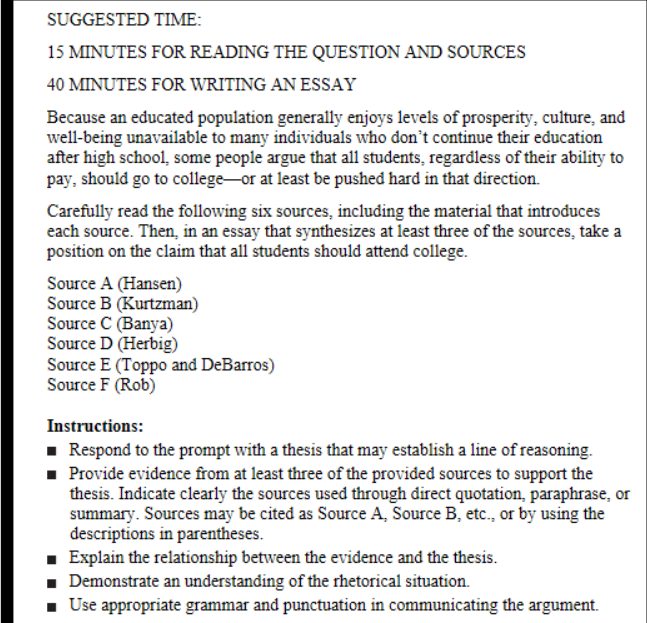
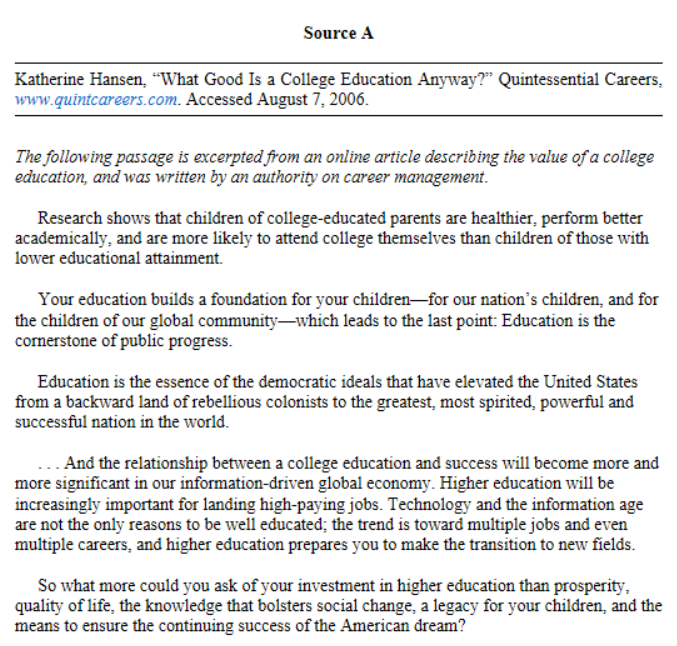
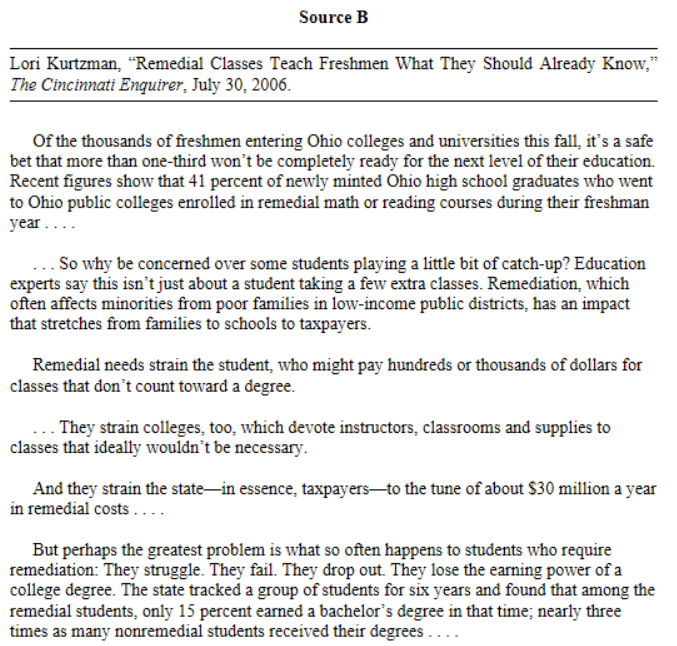
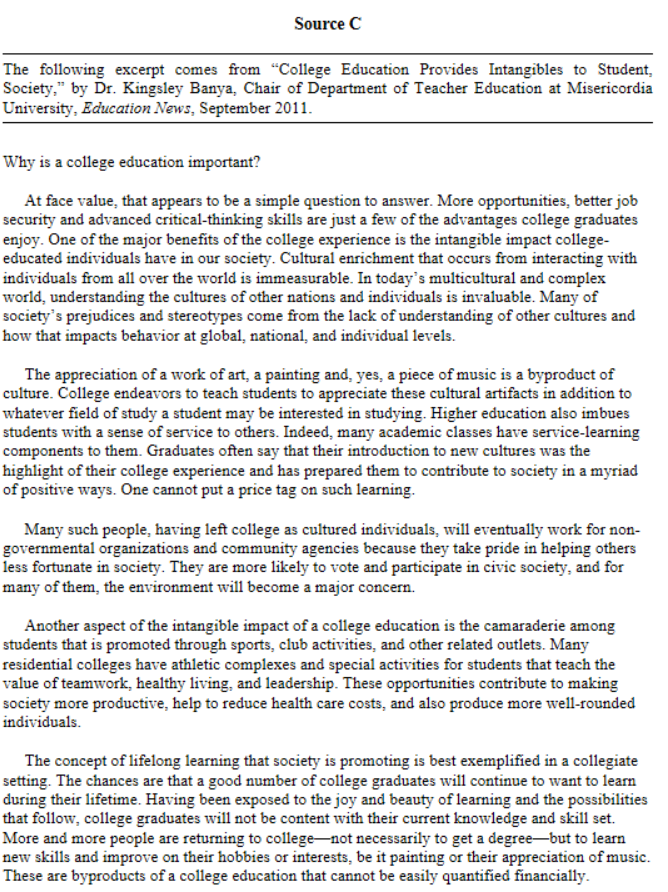
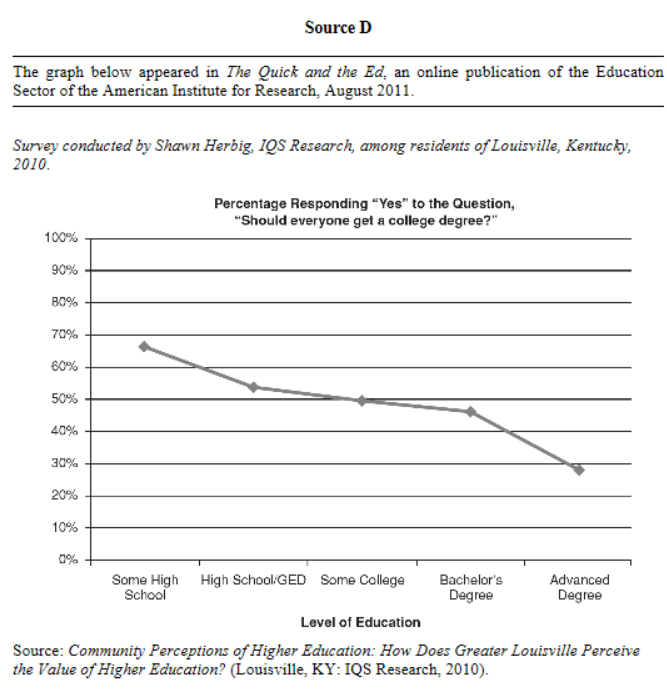
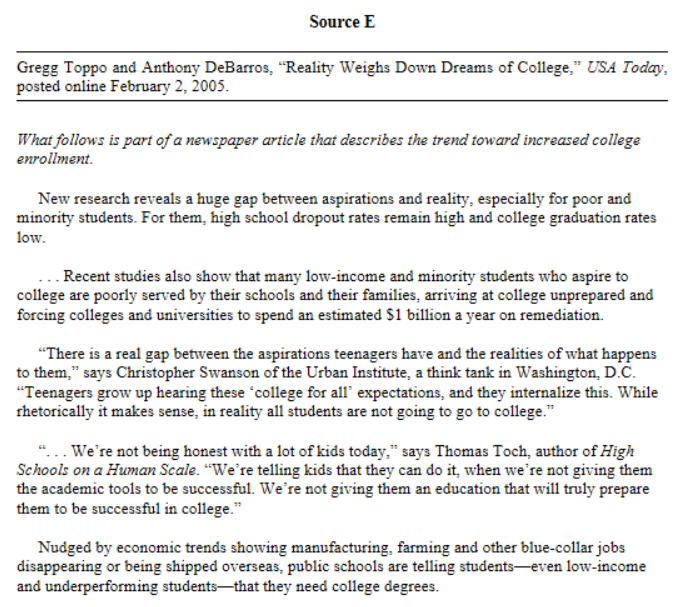
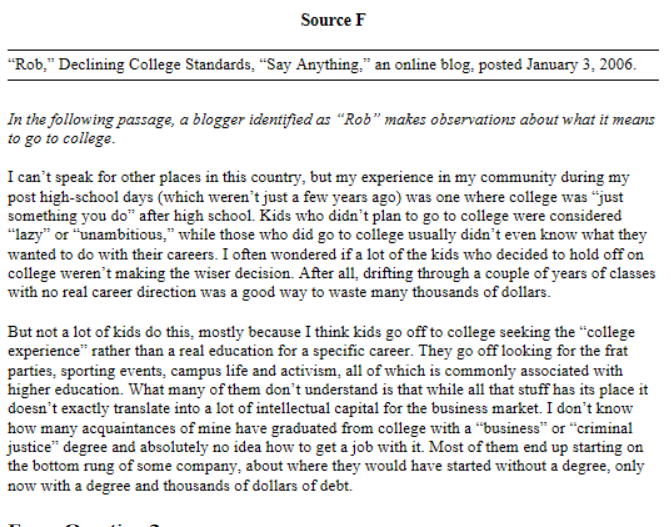
Essay Question 2
SUGGESTED TIME: 40 MINUTES
(This question counts as one-third of the total score for Section II.)
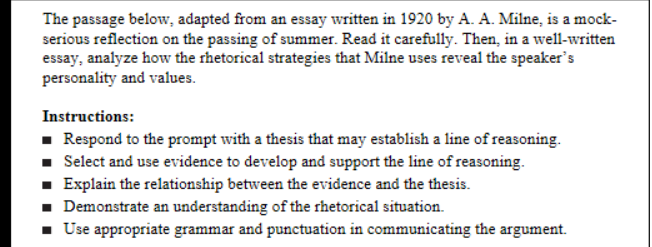
Last night the waiter put the celery on with the cheese, and I knew that summer was indeed dead. Other signs of autumn there may be—the reddening of the leaf, the chill in the early-morning air, the misty evenings—but none of these comes home to me so truly. There may be cool mornings in July; in a year of drought the leaves may change before their time; (5)it is only with the first celery that summer is over. . . .
There is a crispness about celery that is the essence of October. It is as fresh and clean as a rainy day after a spell of heat. It crackles pleasantly in the mouth. Moreover, it is excellent, I am told, for the complexion. One is always hearing of things which are good for the complexion, but there is no doubt that celery stands high on the list. After the burns and (10)freckles of summer one is in need of something. How good that celery should be there at one’s elbow. . . .
“Season of mists and mellow fruitfulness,” said Keats, not actually picking out celery in so many words, but plainly including it in the general blessings of autumn. Yet, what an opportunity he missed by not concentrating on that precious root. Apples, grapes, and nuts (15)he mentions specially—how poor a selection! For apples and grapes are not typical of any month, so ubiquitous are they, while as for nuts, have we not a national song which asserts distinctly, “Here we go gathering nuts in May”? Season of mists and mellow celery, then let it be. A pat of butter underneath the bough, a wedge of cheese, a loaf of bread and—Thou.
How delicate are the tender shoots that unfold layer by layer. Of what a whiteness is the (20)last baby one of all, of what a sweetness his flavor. It is well that this should be the last rite of the meal so that we may go straight on to the business of the pipe. Celery demands a pipe rather than a cigar, and it can be eaten better in an inn or a London tavern than in the home.
Yes, and it should be eaten alone, for it is the only food which one really wants to hear oneself eat. Besides, in company one may have to consider the wants of others. Celery is (25)not a thing to share with any man. Alone in your country inn you may call for celery; but if you are wise you will see that no other traveler wanders into the room. Take warning from one who has learnt a lesson. One day I lunched alone at an inn, finishing with cheese and celery. Another traveler came in and lunched too. We did not speak—I was busy with my celery. From the other end of the table he reached across for the cheese. That was all right! (30)It was the public cheese. But he also reached across for the celery—my private celery for which I owed. Foolishly—you know how one does—I had left the sweetest and crispest shoots till the last, tantalizing myself pleasantly with the thought of them. Horror! To see them snatched from me by a stranger. He realized later what he had done and apologized, but of what good is an apology under such circumstances? Yet at least the tragedy was not (35)without its value. Now one remembers to lock the door.
I can face the winter with calm. I suppose I had forgotten what it was really like. I had been thinking of the winter as a horrid, wet, dreary time fit only for professional football. Now I can see other things—crisp and sparkling days, long pleasant evenings, cheery fires. Good work shall be done this winter. Life shall be lived well. The end of the summer is not (40)the end of the world. Here’s to October—and, waiter, some more celery.
Essay Question 3
SUGGESTED TIME: 40 MINUTES
(This question counts as one-third of the total score for Section II.)
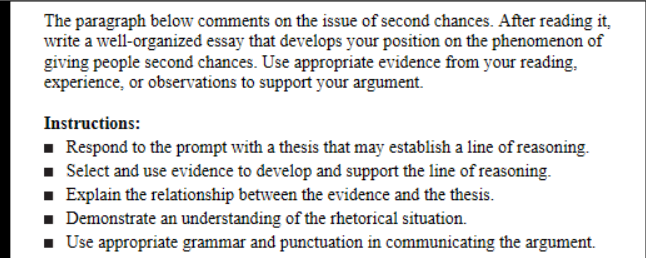
At one time or other, we all do or say things that we regret and would like to do over or take back. Most of the time we must live with our mistakes, but sometimes, we get a second chance. Some people take a dim view of second chances, claiming that second chances not only foster irresponsible behavior but also weaken our character. Others see value in (5)second chances. They say that second chances help us learn and permit us to take intellectual, creative, and other kinds of risks instead of always playing it safe. In your opinion, are second chances desirable, or not?




